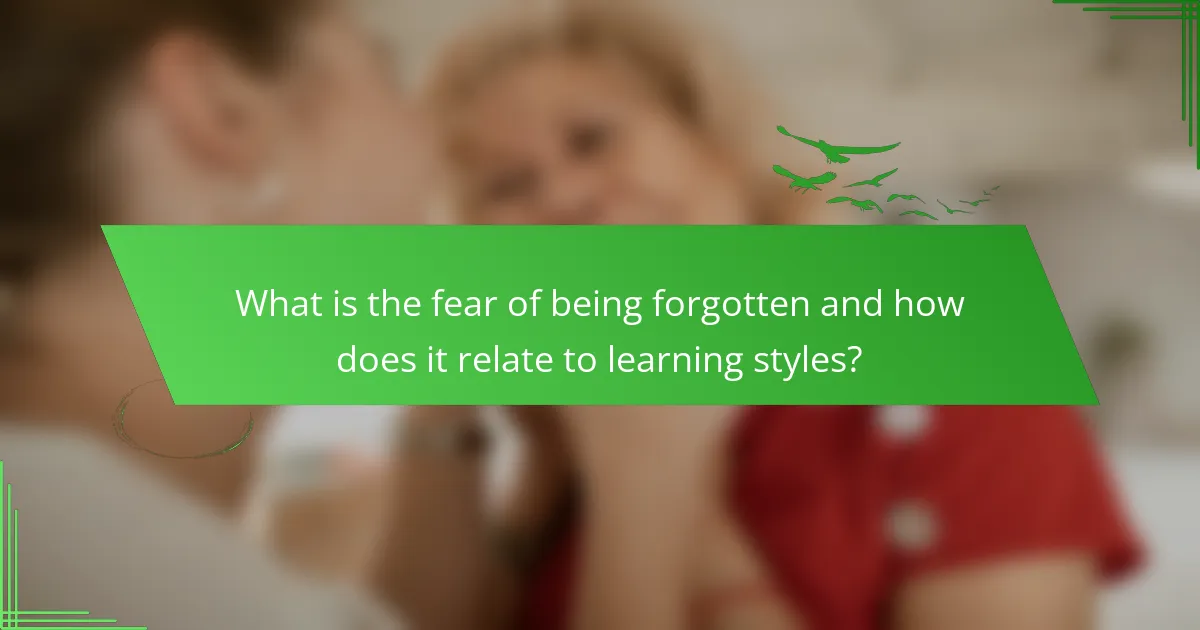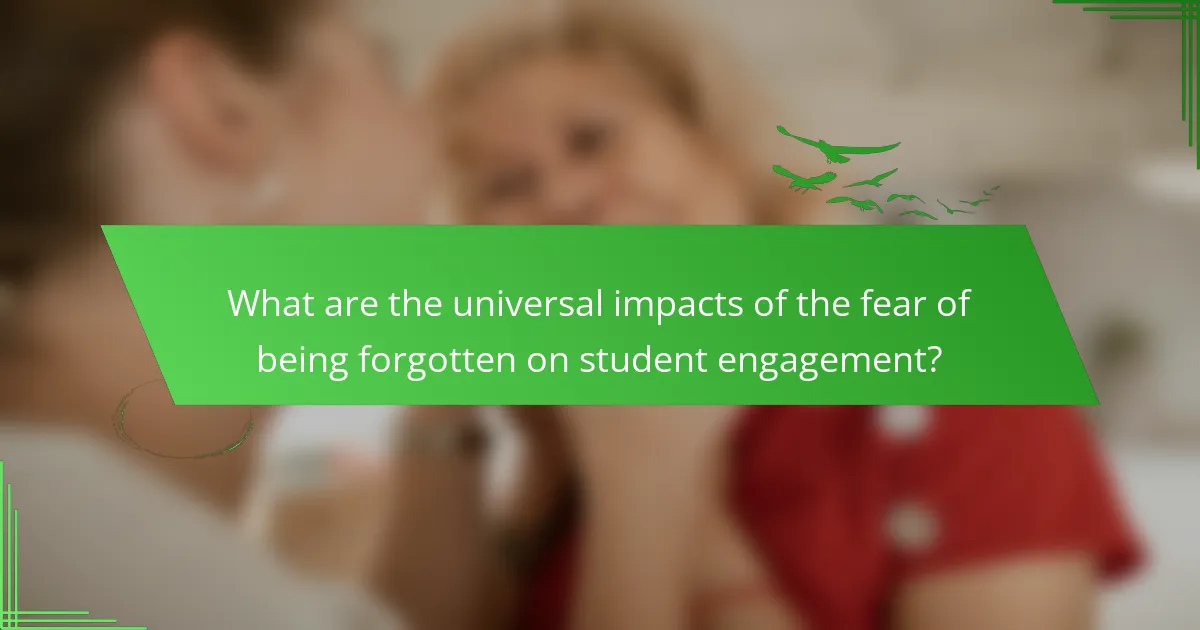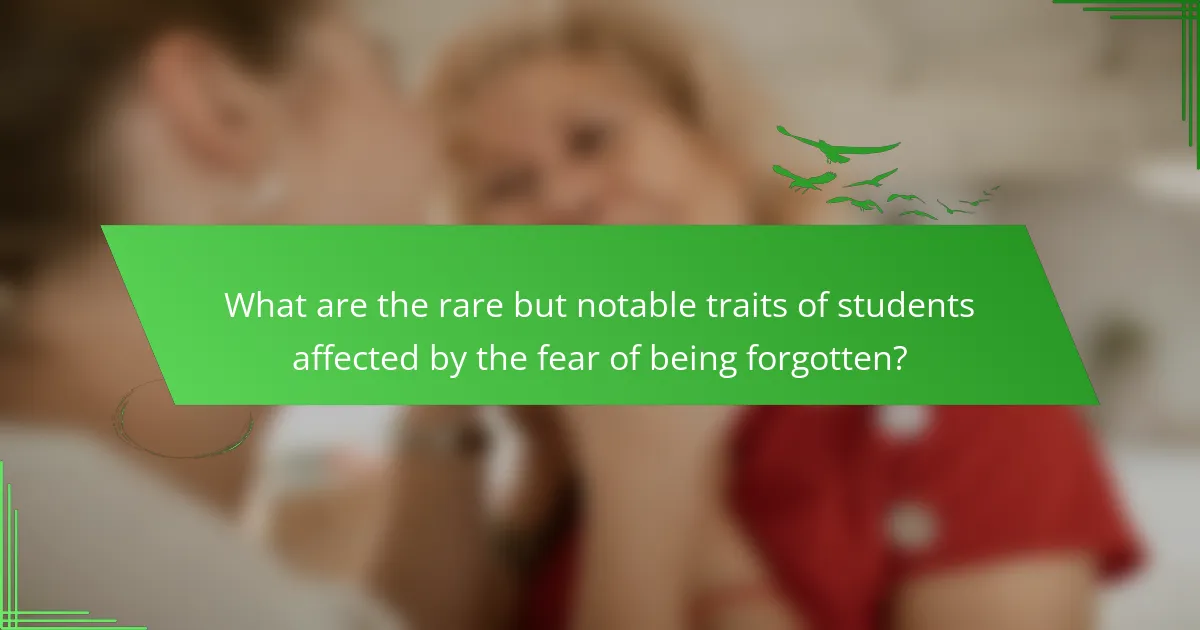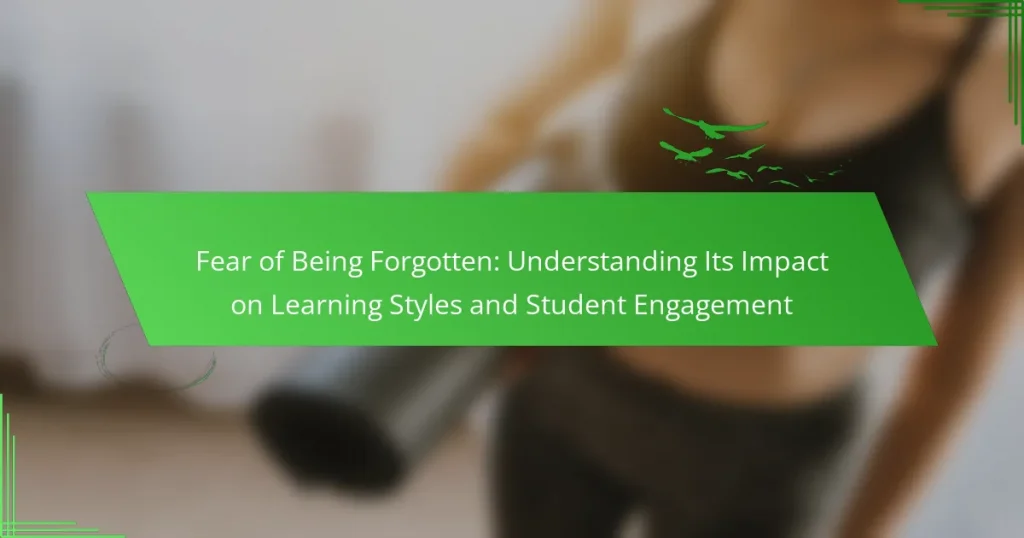The fear of being forgotten can hinder student engagement and affect learning styles. This article explores how this fear leads to increased anxiety and reliance on validation, shaping students’ learning preferences. It discusses the importance of personalized learning and active engagement techniques in creating memorable experiences. Additionally, it highlights the role of supportive environments and consistent feedback in mitigating this fear and enhancing educational outcomes.

What is the fear of being forgotten and how does it relate to learning styles?
The fear of being forgotten significantly impacts learning styles and student engagement. This fear can lead to increased anxiety, affecting how students absorb and retain information. Students may adopt various learning styles, such as visual or auditory, to create memorable experiences that counteract this fear. Engaging teaching methods that emphasize personal connection and recognition can enhance retention and mitigate the fear of being forgotten. Research indicates that students who feel valued and remembered are more likely to engage actively in their learning process.
How does the fear of being forgotten manifest in students?
The fear of being forgotten can manifest in students as anxiety and a heightened need for validation. This fear often drives them to seek constant engagement and recognition from peers and instructors. Students may over-participate in class discussions or excessively share their achievements on social media to combat feelings of invisibility.
Additionally, this fear can lead to avoidance of academic risks, as students might hesitate to express unique ideas or opinions, fearing they will not be remembered positively. As a result, their learning styles may shift towards more conformist approaches, prioritizing acceptance over personal expression.
What psychological theories explain the fear of being forgotten?
The fear of being forgotten is explained by psychological theories such as social identity theory and terror management theory. Social identity theory posits that individuals derive self-esteem from their group memberships; thus, the fear of being forgotten relates to losing social connections. Terror management theory suggests that this fear stems from awareness of mortality, prompting individuals to seek legacy and recognition. These theories highlight the psychological impact of this fear on learning styles and student engagement, as students may strive for visibility and validation in educational settings.
How does attachment theory influence student engagement?
Attachment theory significantly influences student engagement by shaping how students connect with their learning environment. Students with secure attachments tend to engage more actively, feeling safe and supported. In contrast, those with insecure attachments may exhibit anxiety or avoidance, hindering their participation. Understanding these dynamics helps educators tailor strategies that foster a sense of belonging, thereby enhancing engagement and learning outcomes.
What role does self-esteem play in the fear of being forgotten?
Self-esteem significantly influences the fear of being forgotten. Higher self-esteem often reduces this fear, as individuals feel more secure in their identity and contributions. Conversely, low self-esteem can amplify the fear, leading to anxiety about being overlooked or unrecognized. This dynamic affects learning styles and student engagement, as students with low self-esteem may struggle to participate actively in classroom settings. Understanding this relationship is crucial for educators to foster supportive environments that enhance self-esteem and mitigate the fear of being forgotten.
How does this fear affect learning styles?
Fear of being forgotten negatively impacts learning styles by increasing anxiety and reducing engagement. Students may avoid participation due to fear of judgment, leading to passive learning. This fear can hinder the development of unique attributes like critical thinking and creativity. As a result, students may prefer rote memorization over collaborative or experiential learning methods.
What are the common learning styles among students?
Students commonly exhibit visual, auditory, and kinesthetic learning styles. Visual learners prefer diagrams and charts, while auditory learners thrive on lectures and discussions. Kinesthetic learners engage best through hands-on activities. Understanding these styles helps educators tailor instruction, enhancing student engagement and reducing the fear of being forgotten.
How do auditory, visual, and kinesthetic learners experience this fear differently?
Auditory, visual, and kinesthetic learners experience the fear of being forgotten in distinct ways. Auditory learners may internalize this fear through negative self-talk, affecting their engagement in discussions. Visual learners often visualize scenarios of being overlooked, which can lead to anxiety during presentations. Kinesthetic learners might express this fear physically, becoming restless or disengaged when they feel their contributions are undervalued. Understanding these variations helps educators tailor support strategies for each learning style.

What are the universal impacts of the fear of being forgotten on student engagement?
The fear of being forgotten significantly lowers student engagement. This fear drives students to seek validation and recognition, impacting their learning styles. Students may become overly reliant on feedback, which can hinder their intrinsic motivation. As a result, they may prioritize grades over genuine understanding, leading to superficial learning experiences. Addressing this fear through supportive environments can enhance engagement and foster deeper learning connections.
How does this fear influence classroom participation?
Fear of being forgotten significantly reduces classroom participation. Students may hesitate to engage due to concerns about their contributions being overlooked. This fear can lead to anxiety, impacting learning styles and overall engagement. As a result, students might adopt avoidance behaviors, preferring silence over risk. Encouraging a supportive environment can mitigate this fear and enhance participation.
What are the effects on academic performance?
Fear of being forgotten negatively affects academic performance by lowering student engagement and motivation. Students may struggle with anxiety, leading to decreased focus and participation. Research indicates that heightened fear correlates with lower grades and reduced retention of information. Effective strategies to combat this fear include fostering supportive learning environments and encouraging open communication.

What unique strategies can educators use to address this fear?
Educators can utilize personalized learning, active engagement techniques, and continuous feedback to address the fear of being forgotten. Personalized learning tailors experiences to individual students, enhancing their connection to the material. Active engagement techniques, such as collaborative projects and discussions, foster a sense of belonging. Continuous feedback reassures students of their progress, mitigating fears of obsolescence.
How can teachers create a supportive classroom environment?
Teachers can create a supportive classroom environment by fostering trust and open communication. Establishing clear expectations helps students feel secure, while encouraging collaboration promotes engagement. Incorporating diverse learning styles addresses individual needs, enhancing participation. Regular feedback and recognition of achievements build confidence, reducing the fear of being forgotten.
What role does feedback play in alleviating this fear?
Feedback plays a crucial role in alleviating the fear of being forgotten by providing students with recognition and validation. This acknowledgment enhances their engagement and promotes a sense of belonging. When feedback is timely and constructive, it fosters a growth mindset, encouraging students to participate more actively in their learning processes. As a result, students feel more secure in their contributions, reducing anxiety related to being overlooked. Regular feedback also helps identify areas for improvement, reinforcing students’ commitment to their educational journey.
How can peer feedback enhance student confidence?
Peer feedback significantly boosts student confidence by promoting a supportive learning environment. When students receive constructive input from peers, they feel valued and recognized, reducing the fear of being forgotten. This interaction fosters a sense of belonging and encourages active participation in learning. As a result, students are more likely to engage with their peers and contribute to discussions, enhancing their overall learning experience. Moreover, peer feedback cultivates critical thinking and self-reflection, empowering students to recognize their strengths and areas for improvement.

What are the rare but notable traits of students affected by the fear of being forgotten?
Students affected by the fear of being forgotten often exhibit unique traits such as heightened anxiety, increased need for validation, and distinct learning preferences. These students may prefer collaborative learning environments where their contributions are acknowledged. Additionally, they might develop strong emotional connections to educators who provide consistent feedback. This fear can lead to a unique resilience, driving them to seek out opportunities for recognition and engagement in their studies.
How do cultural factors influence this fear?
Cultural factors significantly influence the fear of being forgotten, affecting learning styles and student engagement. Societal values shape perceptions of memory and recognition, impacting motivation. For instance, collectivist cultures emphasize group identity, fostering a stronger fear of being forgotten compared to individualistic cultures. This fear can lead to heightened engagement in collaborative learning environments, as students seek affirmation and connection. Cultural narratives around legacy and remembrance further amplify this fear, influencing students’ emotional investment in their learning experiences.
What are the long-term effects of this fear on a student’s educational journey?
The long-term effects of the fear of being forgotten can significantly hinder a student’s educational journey. This fear often leads to anxiety, which negatively impacts engagement and participation in classrooms. Students may develop avoidance behaviors, resulting in lower academic performance and diminished self-esteem. Over time, this can create a cycle of disengagement and isolation, further exacerbating their fear and hindering their ability to form meaningful relationships with peers and educators. Ultimately, this fear can stifle a student’s potential, limiting their learning experiences and opportunities for growth.

What best practices can educators implement to mitigate the fear of being forgotten?
Educators can mitigate the fear of being forgotten by fostering strong relationships and ensuring consistent engagement. Building a supportive classroom environment encourages open communication. Regular feedback helps students feel valued and recognized. Incorporating diverse learning styles promotes inclusion, allowing every student to connect with the material. Additionally, utilizing technology for reminders and follow-ups keeps students engaged and reinforces their importance in the learning process.
What are effective methods for fostering connections among students?
Fostering connections among students can significantly enhance their engagement and learning experiences. Effective methods include collaborative projects, peer mentoring, and social activities that promote interaction.
Collaborative projects encourage teamwork, allowing students to share ideas and develop relationships. Peer mentoring establishes support systems, where experienced students guide newcomers, fostering a sense of belonging. Social activities, such as group outings or clubs, create informal settings for students to connect, enhancing their overall engagement and reducing the fear of being forgotten.
Implementing these strategies can lead to improved learning outcomes and a more cohesive classroom environment.
How can technology be used to support student engagement?
Technology can enhance student engagement by providing interactive learning experiences. Tools like gamified platforms and collaborative software foster participation and motivate learners. These resources cater to diverse learning styles, addressing the fear of being forgotten by ensuring every student feels included. For example, real-time feedback systems allow students to track their progress, reinforcing their connection to the material. As a result, technology not only supports engagement but also personalizes learning, making it more effective.
What common mistakes should educators avoid when addressing this fear?
Educators should avoid common mistakes that exacerbate the fear of being forgotten, which can hinder student engagement. One mistake is neglecting to create a supportive classroom environment where students feel valued. Another is failing to recognize individual learning styles, which can lead to disengagement. Additionally, using overly complex language can alienate students, making them feel overlooked. Lastly, not providing consistent feedback can reinforce feelings of insignificance.
How can understanding this fear improve teaching methodologies?
Understanding the fear of being forgotten can significantly enhance teaching methodologies by fostering deeper student engagement. By recognizing this fear, educators can implement strategies that create a more inclusive environment, encouraging students to express themselves and participate actively.
For instance, personalized feedback can alleviate students’ anxieties about being overlooked, reinforcing their sense of belonging. Incorporating collaborative projects also addresses the fear, as students see their contributions valued within a group context.
Moreover, integrating storytelling techniques in lessons can resonate with students, making learning more memorable and reducing the likelihood of feeling forgotten. This approach aligns with the unique attribute of emotional connection, enhancing retention and engagement.
Ultimately, understanding this fear allows educators to tailor their methods, ensuring that all students feel recognized and valued in the learning process.




